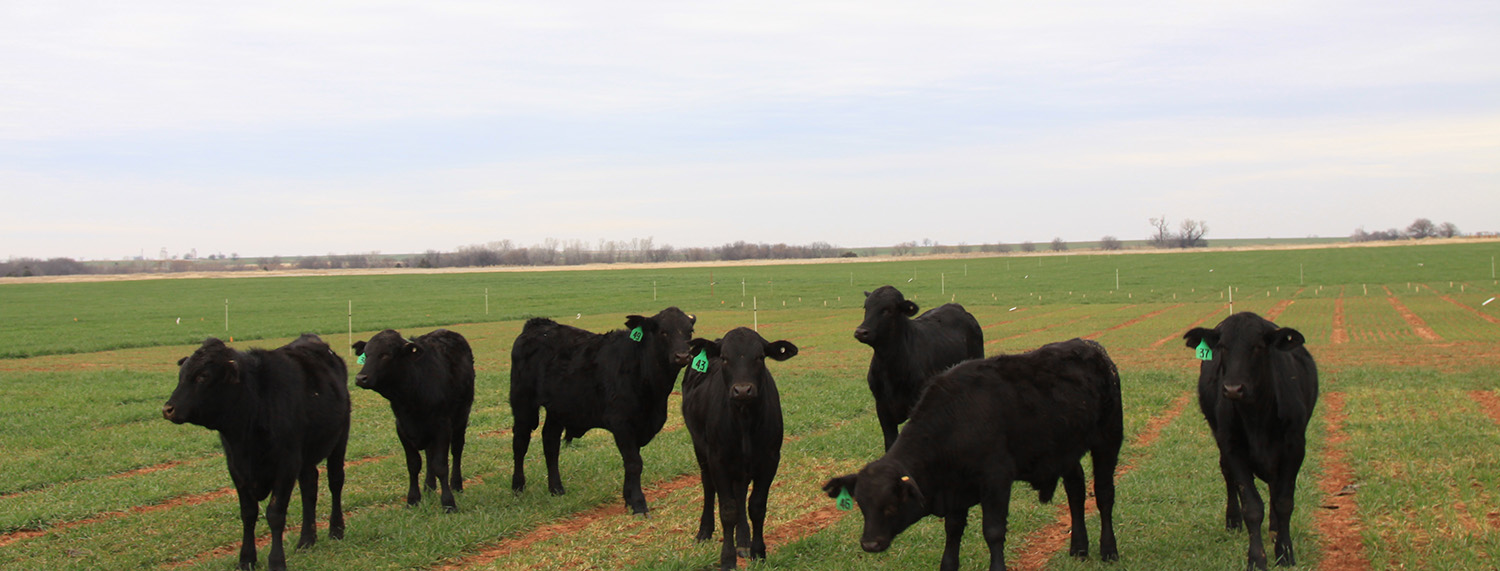Impact of Grazing on Wheat Grain Yield
Background
Oklahoma farmers and ranchers have relied on wheat pasture to diversify income, spread risk, and increase profitability for more than 100 years. Questions regarding the impact of grazing on subsequent wheat grain yield have always been on the minds of producers. OSU research has shown that the effect of grazing on wheat grain yield can be minimized by removing cattle by the first hollow stem stage of growth, and there is a significant wheat grain yield penalty for grazing past this point (OSU Fact Sheet PSS-2147). This leaves the question, however, how much does grazing decrease wheat grain yield when cattle are removed in a timely fashion?
To help answer this question the OSU Small Grains Extension Program conducted side-by-side grazed and non-grazed wheat variety trials at the Wheat Pasture Research Unit near Marshall, Oklahoma from 1991 to 2011 (harvest years). All plots were sown at 120 lb/acre using conventional tillage methods. Pre-plant nitrogen fertilizer was applied at quantities necessary to produce 3,000 lb/acre fall forage followed by 50 bu/ac grain yield. Weed and insect pests were managed according to OSU Extension guidelines. Stocker steers were place on the grazed plots by mid November each year and grazing was terminated by the first hollow stem stage of growth. Non-grazed plots were excluded from the larger research pasture (approx. 20 acres) by electric fence.
Research Results
From 1991 to 1998 (harvest years) grazed and non-grazed plots were both sown in early September. Data from 1994 – 1996 were removed due to insufficient fall growth to allow grazing by cattle. When grazed and non-grazed plots were both sown in early September, wheat yield reduction from grazing ranged from 2 to 8 bu/ac (Table 1).
Table 1. Effect of grazing on wheat grain yield when grazed and non-grazed plots were both sown in early September.
| Year | Grazed | Non-grazed | Difference | |
|---|---|---|---|---|
| bu/ac | bu/ac | bu/ac | ||
| 1991 | 12 | 14 | 2 | |
| 1992 | 37 | 34 | -3 | |
| 1993 | 26 | 29 | 3 | |
| 1997 | 18 | 20 | 2 | |
| 1998 | 52 | 60 | 8 | |
| Average | 29 | 31 | 2 |
Grazing increased grain yield of early-sown plots by 3 bu/ac in 1992. While not typical, it is not unusual for grazing to increase the grain yield of early-sown wheat. The abundant fall growth associated with early-sown wheat is critical for forage production, but when left ungrazed it also increases crop moisture use, likelihood of insect infestations, and foliar disease incidence and severity.
From 1999 to 2011 we compared dual-purpose and grain-only wheat production systems. In this comparison, dual-purpose plots were sown in early September and grain-only plots were sown in mid October. Wheat grain yield reduction associated with grazing ranged from 4 to 14 bu/ac (Table 2). Similar to the 1991 – 1998 data, grazing increased grain yield 3 out of 13 years from 1999 to 2011; however, increases in grain yield in the latter comparison were likely the result of insufficient growth in the grain-only plots.
Table 2. Effect of grazing on wheat grain yield when dual-purpose and grain-only plots were sown in September and October, respectively.
| Year | Dual purpose | Grain only | Difference | |
|---|---|---|---|---|
| bu/ac | bu/ac | bu/ac | ||
| 1999 | 33 | 43 | 10 | |
| 2000 | 44 | 42 | -2 | |
| 2001 | 38 | 44 | 6 | |
| 2002 | 45 | 49 | 4 | |
| 2003 | 53 | 50 | -3 | |
| 2004 | 39 | 51 | 12 | |
| 2005 | 16 | 30 | 14 | |
| 2006 | 22 | 28 | 6 | |
| 2007 | 16 | 30 | 14 | |
| 2008 | 54 | 63 | 9 | |
| 2009 | 8 | 21 | 13 | |
| 2010 | 44 | 36 | -8 | |
| 2011 | 18 | 29 | 11 | |
| Average | 33 | 40 | 7 |
Implications for Producers
The combination of earlier-September planting and grazing by cattle typically reduce the grain yield of dual-purpose wheat. In our studies, grazed wheat yielded approximately 6% less than non-grazed wheat sown at the same time, and dual-purpose wheat yielded approximately 18% less than grain-only wheat when systems were compared. The difference between these two values (12%) indicates that early sowing accounts for approximately 2/3 of the yield penalty associated with dual-purpose wheat production and grazing accounts for approximately 1/3. This comparison indicates that once a producer has made the decision to sow wheat in early September, much of the yield penalty associated with dual-purpose management has already been incurred.
Yield loss from dual-purpose management is not absolute. In our study grazing increased wheat grain yield approximately 20% of the time. Increases in grain yield from grazing are likely in early-sown wheat when grazing reduces water use and foliar diseases of wheat. Similarly, dual-purpose wheat can outperform grain-only wheat when winter conditions prevent adequate tillering of October-sown wheat.
Wheat grain yield is only one component influencing the profitability of the dual-purpose wheat production enterprise, and the data presented in this fact sheet are insufficient to make determinations as to the overall profitability of dual-purpose or grain-only production systems. These data do, however, provide guidelines that can be used in budgeting or in determining appropriate wheat pasture rental rates.

Cattle graze dual-purpose plots near Marshall, OK. Grain-only plots in the rear were excluded from grazing by electric fence.
Jeff Edwards
Small Grains Extension
Brett Carver
Wheat Breeding
Gerald Horn
Former Beef Cattle Nutrition and Management
